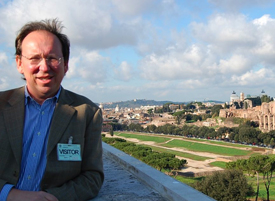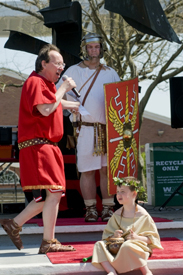Classics professor brought love of antiquity to American Academy in Italy

When in Rome, Corey Brennan did exactly as the Romans do.
That is, if Romans routinely play host to American photography superstar Annie Leibowitz as she tours the Eternal City, chat with Doonesbury cartoonist Garry Trudeau or break bread at the legendary Villa Aurora with Woody Allen, in town to film his latest comedy.
Freshly back at Rutgers after three years at the helm of the School of Classical Studies of the American Academy in Rome, the former chair of the Classics Department in the School of Arts and Sciences is simultaneously looking ahead to life on campus and looking back on his tenure at the 118-year-old academy.
The academy, an American center for independent study of humanities and the arts in Italy, plays host to 30 winners of the Rome Prize every year, all invited to Rome to pursue work in the shadow of the Pantheon, the Colosseum and the Forum.
Brennan is no stranger to the prize, having won it himself in 1987 as a graduate student in classical studies at Harvard University.
Rutgers scholars have been a presence at the academy since its inception, Brennan says, but he is the first from the university to serve as the head of the Humanities Division – formally known as the Andrew W. Mellon Professor in Charge, less formally known as the scholar who sets the intellectual tone for the division.

It was a heady challenge for this lover of antiquity, a man who spends much of his professional life looking for the bridges between the ancient and the modern.
“The ancient Greek and Roman worlds permeate much of our own world, and I’m interested in seeing connections, making connections,” Brennan says. “For me, it’s all about development and relevance – tracing how the highways of history inform how we act today.”
Among Rutgers colleagues in Rome with him during the course of his tenure were Rome Prize fellows Stephen Westfall, professor of painting at Mason Gross School of the Arts, and Carly Jane Steinborn, a graduate student in the history of art.
In addition to steering the center’s academic ship, Brennan’s responsibilities included staging conferences, exhibitions and other large-scale events. It wasn’t much of a stretch for the professor who brought Supreme Court Justice Samuel Alito to Rutgers to reflect on growing up Italian-American in New Jersey. The talk drew a capacity audience to the Student Center in February 2008.
A highlight of Brennan’s Roman adventure was coordinating an international conference to mark the 50th anniversary of the Rome Olympics, which brought together athletes and others in a multi-disciplinary event focusing on the lasting impact on the architecture and infrastructure of the 1960 Summer Games.
The conference both sparked and reflected Brennan’s growing passion for Italian architecture. That passion finds expression in a book he is now co-editing on the work of the architect Luigi Moretti, who designed the Watergate complex in Washington as well as many of the buildings in his native Rome from the 1930s to the 1970s.
“My time at the academy gave me a sense of the history of the sites and the artifacts of Rome, the way antiquity affects the modern period, the notion of historical continuity,” Brennan says.
“In addition to thinking of Rome as an ancient city, I concentrated on Rome as a baroque city, a fascist city and an Olympic city. Rome was the first city to change its infrastructure to accommodate the Olympics, for example. And they did it very successfully.”
Brennan also commissioned and oversaw a series of artistic installations and musical performances celebrating the 400th anniversary of the day Galileo first demonstrated his telescope in Rome; the term “telescope” was coined for the occasion.
More than 800 people came to the grounds of the academy to hear artists, scientists and composers interpret the contributions of the Florence-born astronomer, and to view an exhibition of scientific instruments from the Vatican collection.
And then there was that dinner with Woody Allen and his wife Soon-Yi Previn while the film-maker was overseeing production of “To Rome with Love,” his ensemble valentine to the city released last summer.
“I actually found myself thinking I was playing the character of a professor in one of his movies while sitting through the dinner,” the Rutgers academic recalls. Table talk centered on the works of director and screenwriter Federico Fellini and the economics of the Italian film industry.
Back at Rutgers, Brennan is now teaching courses in Greek civilization, and in the legacy of Greek and Roman athletics through the Summer Olympics through 2012, with an emphasis on stadium design. In the spring he will lead a Byrne seminar on Mussolini’s Rome – yet another direct outgrowth of his experience at the academy.
Open to first-year students, the one-credit Byrne Family First-Year Seminars offer students an opportunity to explore science, art, politics and other topics with professors who are deeply immersed in research.